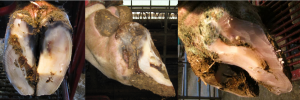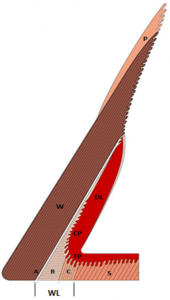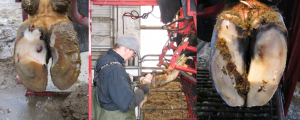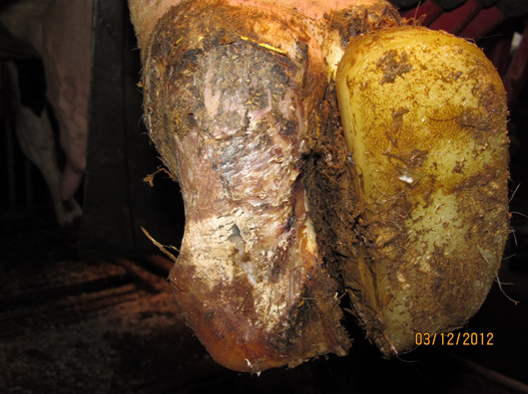Bovine Lameness and Podiatry
White line disease
G Cramer
What is it?
White line disease encompasses a range of lesions that typically occur in the abaxial white line region towards the heel or outside digit of the rear foot. On most dairy farms it is one of the three most common causes of lesions and lameness.
How to recognize it?
White line lesions range from hemorrhages to separations and abscesses. Lame cows typically present with areas of white line separation that are painful when tested with hoof testers or areas of more extensive hoof wall separation that can extend up to the coronary band.

Pathogenesis
The exact cause of white line lesions is unclear. What is known is that the white line is a made up 3 different types of horn and white line horn is weaker than the wall or sole horn.
The current theory is that white line disease occurs in a similar fashion to sole ulcers: P3’s suspensory mechanism is compromised and this results in damage to the keratinocytes that grow white line horn. The presence of both shearing forces and weaker horn at the white line allows the formation of fissures.

These fissures can allow the entry of bacteria and foreign bodies resulting in damage to the corium and inflammatory changes to P3.
How do you prevent white line disease?
Prevention of white line lesions starts with avoiding excessive trauma to the white line region by ensuring both cow walking surfaces and cattle handling allows the cow to walk at their own pace and not slip.

Supplemental minerals (Cu/Zn) and biotin can be added to the diet to increase horn strength.
Finally the strategic use of an appropriately timed and correctly performed hoof trimming is a key component of any prevention program.

How do you treat a white line lesion?
White line disease can appear as an acute and painful condition. However, there are gradients of white line lesions and appropriate early treatment is critical to successful resolution. Any cow with separation of the white line and a withdrawal response to hoof testers should be treated. Due to the pain, NSAIDs or other analgesics are indicated.
The treatment of painful white line lesions involves the removal of all loose horn around the lesion including the wall. This removal should occur delicately, with great care taken to minimize further damage to the corium. Do not dig holes but cup the area to prevent trapping of manure.

Once loose horn has been removed around the lesion, pressure on the lesion should be reduced to maximize the speed of horn growth. Lower the heel up to the toe triangle (middle image above). The reduction of pressure on the lesion is achieved by the removal of horn around the lesion and by application of a properly sized hoof block to transfer weight to the sound digit.
Cows with white line disease should be rechecked in 3-6 weeks to assess healing, and to either remove or reposition the block if necessary. Recovery can take 2-6 weeks.

Further damage should be prevented by minimizing the risk of moving too fast or slipping while walking (torque is bad). Minimizing walking minimizes risks.
Key Takeaways
White line disease is compromise of the laminar junction. Bacteria and debris can enter the space, causing further damage. White line disease is associated with cattle moving too fast or slipping while walking. Treatment involves opening up the infected area and removing loose horn. A block is placed on the opposite digit to permit the area to heal
Resources
Lameness originating in the hoof of cattle, Cramer and Solano, merckvetmanual.com
Pathogenesis and Treatment of Sole Ulcers and White Line Disease; VCNA FA 2017; Volume 33, Issue 2, July 2017, Pages 283-300
An Update on the Assessment and Management of Pain Associated with Lameness in Cattle VCNA FA 2017; Volume 33, Issue 2, July 2017, Pages 389-411

